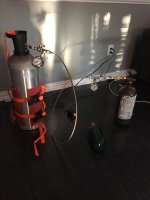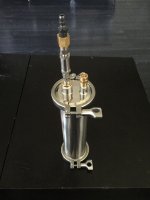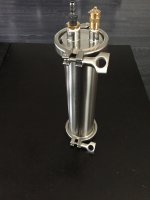I have good experience with supercritical CO2, its awesome because of its polarity being so low. But with it the troubles I have also outlined in the general extraction thread come:
With the setup I build myself long ago I can not run a continous extraction (like most MJ people would do with butane) so since a while I am considering either using butane of evaluating a circulating CO2 system with a choke. a compressor and a heating element.
I highly recommend TIG welding a extraction chamber from stainless steel (and not bother about "being able to see in there or you learn the hard way that supercritical CO2 can creep into acrylic

) and heat it on a lab style heater. Thats a simple setup and does the job for non-continous extraction, meaning you add everything to your reaction chamber, your plant matter and your CO2 from a siphoned bottle ( or turn your bottle upside down :/ ) and the correct amount of heat and let that sit. This process does leave desired goods in your plant material, since the concentration in your chamber will be the same everywhere, in your solvent and your plant matter. Continous Extraction would help with this issue, the device sketched above would also cut down on CO2 use by recycling. I have just not yet found if the supercritical state might do something I do not expect when the CO2 encounters a choke like those in traditional cooling systems.
Hieronymous, if you really want to make use of the lathe (sawing of heavy stainless tubing and welding it shut on both ends does the job lathe free) and youre concerned about the pressures and forces involved, spin yourself two half spheres of tough stainless and you'll be able to wels yourself a spherical chamber that fits into a round bottom flask heater and is, because of its shape, the thoughest you can go.
I would highly recommend to go for it, just for the experience

I must admit personally I've come to mostly simply use the Soxhlet apparatus with methanol, no trouble, good yields, ease of opperation, I've even stopped using the glass or cellulose containers that go inside and simply stuff it with somw cotton at the base and top, works





